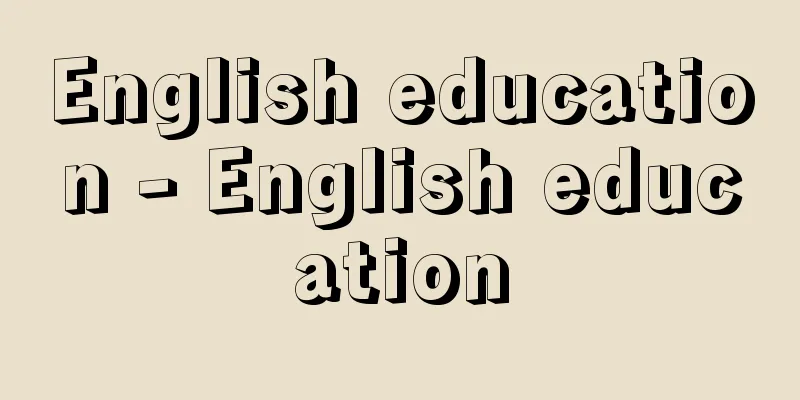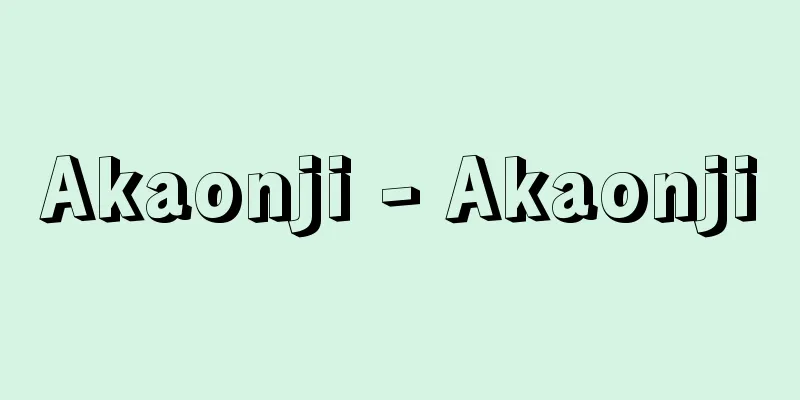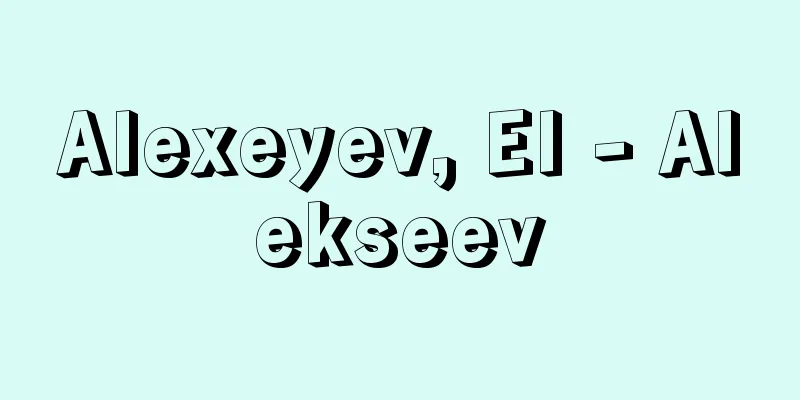English education - English education

|
In documents from the Meiji and Taisho periods, the term "English professor" was often used, while "English education" was rather rare and probably only began to be used in the Showa period. Modern English education in Japan aims to teach English as a foreign language through English. Therefore, in addition to teaching English, it also teaches an English way of thinking. The significance of English education is to sharpen linguistic sense through comparison with one's native language, to develop people who can think from a broader perspective by turning a perspective that tends to be monocular into a multifaceted one, and to acquire the ability to communicate will and ideas with people who speak different languages through English, which has become one of the international languages. historyIt is said that the first person to introduce English to Japan was the Englishman William Adams (Miura Anjin), but the study of English is said to have started in 1808 (Bunka 5) when the Shogunate ordered several Nagasaki interpreters to study English as well after the incident involving the British warship Phaeton. Furthermore, in 1857 (Ansei 4), English studies began to be taught at the Bansho Shirabesho (Institute for the Investigation of Foreign Documents), which had previously focused on Dutch studies. The Bansho Shirabesho was renamed the Yosho Shirabesho (Institute for the Investigation of Foreign Documents) in 1862 (Bunkyu 2), and the Kaiseisho (Institute for the Investigation of Foreign Documents) in August of the following year, and was succeeded by Daigaku Nanko (the predecessor of Tokyo University) in the Meiji period. The first person to be employed at Daigaku Nanko as an English and academic instructor in 1869 (Meiji 2), who later became vice principal and achieved great success among the foreigners employed at the school, was the American Verbeck. With the implementation of the education system in 1872 (Meiji 5), foreign languages were officially added to the school subjects, and in secondary schools in 1886 English became the first foreign language, with German or French being options. After the First Sino-Japanese War of 1894-95 (Meiji 27-28), the Russo-Japanese War of 1904-05 (Meiji 37-38), and World War I of 1914-18 (Taisho 3-7), Japan's international status improved and as overseas trade developed, the need for English education became keenly felt, and class hours increased. However, the results of English education were not necessarily as expected, and in 1917 (Taisho 6), arguments about whether to keep or abolish English arose again in 1927 (Showa 2). From around 1935, criticism of English education gradually increased, and with the outbreak of the Pacific War in 1941 (Showa 16), English education was heavily suppressed as it was seen as an act of aiding the enemy, to the point that some secondary schools even abolished English classes altogether. After World War IIHowever, with the end of the Pacific War in 1945, English education became popular again, and in the new junior high schools that were established in 1947, foreign languages (English) were included in the compulsory education curriculum, albeit as an elective subject. However, many of the English teachers who had received specialized training were absorbed into the new high schools, and junior high schools suffered from a severe shortage of English teachers. English education was subsequently improved, and in 1956, English was added to the high school entrance examination in all prefectures, and with the development of audiovisual equipment, language laboratories became widespread, and in 1961, the Language Laboratory Association (now the Foreign Language Education Media Association) was founded. The construction of English education as a discipline also progressed, and in 1975, the Japan Association for English Language Education was founded. On the other hand, due to a policy to reduce the number of class hours overall in order to provide more leisure and fulfillment in school education, the number of hours of English in junior high schools nationwide was reduced from four hours a week to three hours in April 1981, which sparked controversy. Towards communication-oriented English educationLater, in an internationalized society, expectations for English language learning increased, and many protests were raised against the reduction in the number of English classes. In 1989, the revised curriculum guidelines returned junior high school English to four hours per week. In 1994, a new subject, "Oral Communication A, B, and C," was added to high schools with the aim of further improving English language proficiency. There was an increasing demand for communication-oriented English education, and in the last revision of the 20th century, which was carried out in junior high schools in 1998 and in high schools in 1999, the goal was to develop practical communication skills. The new curriculum guidelines aim to enable students to carry out appropriate communication activities according to the situation in which the language is used and the function of the language. What is also noteworthy is that this revision made foreign language classes compulsory in junior high schools and high schools. This is likely due to the recognition that in today's increasingly internationalized world, proficiency in foreign languages, especially English, is essential. Many private junior and senior high schools are already placing emphasis on English education, and many have been well-received for increasing the number of English classes and setting aside time for English conversation taught by foreign teachers. Meanwhile, in an effort to prevent students from "leaning away from public schools," public high schools have responded to the Central Council for Education's report in 1991 by establishing international departments to enhance foreign language education, actively accepting children of returnees, and forming sister school ties with schools abroad. Centered on the general studies department established in 1994, schools are competing with private schools by offering courses such as "advanced communication" and "Internet English." This trend is having a ripple effect in many areas. The introduction of foreign language conversation classes in elementary schools is one example. The first examples of so-called early English education for elementary school students and preschoolers can be seen in the outline of Keio Gijuku Kindergarten in 1881 (Meiji 14). However, it became a social phenomenon after World War II and the number of schools has continued to grow. In the 1990s, there was a noticeable increase in statements calling for the introduction of English education in elementary schools, and finally in 1993 (Heisei 5), two model schools were established. Then, in the curriculum guidelines introduced in 2002, foreign language education was positioned for the first time as part of international understanding education in "integrated study period." Expanding educational opportunitiesNowadays, English learning opportunities have expanded beyond the bounds of school education to include various cram schools, English conversation classes, and the mass media. At the end of the 1990s, 25% of elementary school students and over 60% of junior high school students attended cram schools, including English cram schools. Given these numbers, there is even a movement to position cram schools as official educational institutions. English conversation classes have also flourished, catering to a wide range of students from preschoolers to working adults, and many of them offer unique education. In-house English education for working adults is also popular, and by the early 1990s more than half of major companies had language training programs in place, and 30% had study abroad programs. Radio English courses, which were started by Okakura Yoshisaburo in 1925 (Taisho 14), were further expanded after the Second World War, and in 1957 (Showa 32) English programs were added to the list. In addition, school broadcast English programs began on radio in 1949 and on television five years later, as well as correspondence courses which have been broadcast since around the same time. Since the 1990s, English courses for entrance exams using satellite broadcasting have also become popular. Reflecting this fervent desire to learn English, the number of people taking various English proficiency tests is steadily increasing. Approximately 3.5 million people take the EIKEN test each year, which began in 1963, approximately 120,000 take the TOEFL test, an English proficiency test for people studying abroad, and approximately 1 million take the TOEIC test, a practical English communication proficiency test used by companies and other organizations. At the same time, the number of people studying abroad has exceeded 60,000 per year (including those in non-English-speaking countries), and the number of people going on school trips overseas has reached approximately 150,000 (all data from the end of the 1990s). The History of English Teaching MethodsUntil the middle of the Meiji period, most secondary schools ignored pronunciation and used a translation style based on classical Chinese with furigana and hiragana punctuation marks, which they called the "irregular teaching method." Later, in works such as Toyama Masakazu's English Teaching Method in 1897 (Meiji 30) and Okakura Yoshisaburo's English Education in 1911 (Meiji 44), criticism of the "irregular teaching method" was presented along with arguments for improving teaching methods. Harold Palmer, who came to Japan in 1922 (Taisho 11), spent 14 years trying to improve teaching methods and working to popularize the oral method. After the Second World War, the oral approach was introduced as a foreign language teaching method based on American structural linguistics. It used materials based on the analysis and comparison of the structures of English and Japanese, and aimed to have students learn completely orally. It also used a technique called pattern practice. However, this method was criticized as being a formal and mechanical exercise of manipulating sentence structure patterns, and not language usage itself. In the 1970s, cognitive learning theory based on generative grammar and cognitive psychology was proposed, but it was only put into practice in some areas. After that, sociolinguistic research progressed, and English education was influenced by it, and a stance of emphasizing interpersonal communication was taken. Instead of the traditional syllabus (class content) centered on grammar and structure, the idea of a "concept-function syllabus" was advocated, that is, a syllabus centered on the functions of language, or on the classification of speech acts and concepts, rather than the forms of language. Since the 1990s, English education has been conducted with the aim of cultivating the ability to use language appropriately according to the situation, rather than focusing on grammatical accuracy. The teaching methods used in school English education have also changed, with the introduction of team teaching with foreign teachers bringing about a major change. The English Instructor Assistant System, which began in 1977, was expanded further to invite foreign youth to Japan for language instruction by inviting assistant language teachers (ALTs), and by 1999 their number had exceeded 5,200. Educational equipment has also improved remarkably, with an increasing number of schools equipped with CALL (computer assisted language learning). In the future, distance education using the Internet will become possible, and the possibilities for new forms of English education will likely expand even further. [Naomi Kakita and Nobukazu Matsuura] "The Teaching and Learning of English as a Foreign Language" by C. Freese, translated by Akira Ohta (1962, Kenkyusha) " ▽ "100 Years of English Studies in Japan, edited by Kiyoshi Omura, Kenkichi Takanashi, and Chikara Shinagawa, 4 volumes (1968-69, Kenkyusha)" ▽ "Specifics of English Teaching Methods" by Yoshio Ogawa and Kenzo Ito (included in Modern English Education, Volume 3, 1978, Kenkyusha)" ▽ "Sources on the History of English Education, edited by Kiyoshi Omura, Kenkichi Takanashi, and Nariyuki Deki, 5 volumes (1980, Tokyo Horei Publishing)" ▽ "Dictionary of Contemporary Keywords in English Education, edited by Akikazu Ando (1991, Masushindou)" ▽ "H. Douglas BrownPrinciples of Language Learning and Teaching 4th edition (2000, Prentice Hall)" [References] | | | | | | | | | | | |Team teaching| | | | | | |Source: Shogakukan Encyclopedia Nipponica About Encyclopedia Nipponica Information | Legend |
|
明治・大正時代の文献では「英語教授」という言い方がよく使われていて、「英語教育」はむしろまれで、おそらく昭和になってから使われ始めたものと考えられる。わが国における現代の英語教育は、英語を外国語として英語によって学習することを目標としている。したがって、英語の教授とともに、英語的な思考形式を教授していることになる。英語教育の意義は、母語との比較を通じて言語感覚を鋭くするとともに、ともすれば単眼となりがちな見方を複眼として、広い視野にたって考える人間を形成することにあり、また国際語の一つとなった英語を通して、言語を異にする人々と意志、思想を伝達しあう道具として身につけることにある、といってよいであろう。 歴史わが国に英語を初めて伝えたのはイギリス人のウィリアム・アダムズ(三浦按針(あんじん))とされているが、英語学習が始まったのは1808年(文化5)のイギリスの軍艦フェートン号事件をきっかけに、幕府が長崎通詞(つうじ)数名に英語の兼習を命じたこととされている。さらに1857年(安政4)には、従来の蘭学(らんがく)を中心とした蕃書調所(ばんしょしらべしょ)において英学が講じられるようになった。蕃書調所は1862年(文久2)に洋書調所、翌年8月に開成所と改称され、明治時代の大学南校(東京大学の前身)に続いた。なお、この大学南校に1869年(明治2)初めて英語学および学術教師として雇用され、のちに教頭となりお雇い外国人のなかでも多大の業績を残したのが、アメリカ人フルベッキであった。 1872年(明治5)の学制施行によって、外国語は正式に学校の教科目に加えられ、中等学校では86年に英語を第一外国語とし、ほかにドイツ語、フランス語のどれかを加えうることになった。 1894~95年(明治27~28)の日清(にっしん)戦争、1904~05年(明治37~38)の日露戦争、1914~18年(大正3~7)の第一次世界大戦を経てわが国の国際的地位が向上し、海外貿易の進展につれて英語教育の必要性が痛感され、授業時間が増加した。しかし反面、英語教育の成果はかならずしも期待どおりにはあがらず、1917年(大正6)に続いて27年(昭和2)には英語存廃論がふたたびおこり、35年ごろを境としてしだいに英語教育に対する批判が高まり、41年(昭和16)の太平洋戦争の開戦とともに、英語教育は利敵行為として極度に圧迫され、中等学校のなかには英語科を全廃するところも出るほどであった。 第二次世界大戦後しかし、1945年(昭和20)太平洋戦争の終結とともに英語教育はふたたび盛んとなり、47年に発足した新制中学校には、選択科目とはいえ、義務教育の課程に外国語(英語)が含められることになった。しかし、専門教育を受けた英語教師の多くは新制高等学校に吸収されたため、中学校では英語教師の著しい不足に悩んだ。その後、英語教育は充実され、56年(昭和31)にはどの府県でも高等学校入学選抜テストに英語科が加えられるようになり、視聴覚機器の開発に伴ってランゲージ・ラボラトリーlanguage laboratoryが普及し、61年には語学ラボラトリー協会(現在は外国語教育メディア学会)が設立された。英語教育の学としての構築も進み、75年には全国英語教育学会も誕生した。一方で学校教育におけるゆとりと充実をもたらすための全体の授業時間数削減の方針により、81年4月から全国的に中学校の英語が、それまでの週4時間から3時間となって、論議をよんだ。 コミュニケーション重視の英語教育へその後、国際化する社会のなかで英語学習に対する期待が高まり、英語の授業数削減には多くの抗議の声があがった。そして、1989年(平成1)の学習指導要領の改訂で中学校の英語は週4時間に戻された。また高等学校には、94年から英語運用力のいっそうの向上を図ることを目的に、科目「オーラル・コミュニケーションA・B・C」が新たに加えられた。その後もコミュニケーション指向の英語教育がますます求められ、98年中学校、99年高等学校で行われた20世紀最後の改訂では、実践的コミュニケーション能力の養成が目標に掲げられた。新しい学習指導要領は、言語の使用場面や言語の働きに応じて、適切なコミュニケーション活動が行えるようになることを目ざしている。さらに特筆すべきは、この改訂で、中学校および高等学校において外国語科が必修になったことである。いっそうの国際化が進む今日、外国語、とりわけ英語の運用力が不可欠であるという認識によるものであろう。 私立中学校や高校ではすでに英語教育に重点を置く学校も多く、英語の授業数を増やし、外国人教師による英会話の時間を設けることで好評を博しているところが多い。一方、公立高校でも、入学者の「公立離れ」を防ごうと、1991年(平成3)の中央教育審議会答申を受けて、国際科を設けて外国語教育を充実させたり、積極的に帰国子女を受け入れたり、また外国の学校と姉妹校提携をする学校が現れてきた。94年から設置された総合学科を中心に、「発展コミュニケーション」「インターネット英語」などの授業科目を開設して私立学校に対抗している。 このような流れは、さまざまな面へ波及効果を及ぼしている。小学校への外国語会話の導入もその一つである。小学生や未就学児童を対象とする、いわゆる早期英語教育の最初は、1881年(明治14)の慶応義塾幼稚舎の概則にみられる。だが、ブームの観を呈するようになったのは第二次世界大戦後の社会現象で、その数は増え続けた。1990年代に入り、小学校への英語教育導入を促す発言が目だって増え、ついに93年(平成5)に二つのモデル校が設置された。そして、2002年導入の学習指導要領では、「総合的な学習の時間」のなかで、国際理解教育の一環として外国語教育が初めて位置づけられることになった。 教育機会の広がり英語学習の場はいまでは学校教育の枠を越えて、各種の学習塾や英会話教室、マス・メディアによるものへと広がりつつある。1990年代の末では、英語塾も含めた学習塾に通う小学生が25%、中学生で60%を超えている。その数から、塾を正式な教育機関として位置づけようという動きがあるほどである。また、英会話教室も隆盛を極め、幼児から社会人までその対象は広範囲で、ユニークな教育を行っているところも多い。社会人を対象とする企業内英語教育も盛んであり、1990年代初頭までに大手企業のうちの半数以上が語学研修制度を整え、3割の企業が留学制度を設けている。また、1925年(大正14)に岡倉由三郎(よしさぶろう)によって始められたラジオによる英語講座は、第二次世界大戦後ますます充実され、57年(昭和32)からはテレビによる英語番組も加わった。このほか、1949年からラジオで、また5年後にはテレビで、それぞれ始まった学校放送英語番組や、ほぼ同じころから放送されている通信教育講座などのほか、90年代以降は衛星放送を利用した受験英語講座も盛んである。 このような熱心な英語学習意欲の反映もあって、各種の英語検定試験の受験者も増加の一途をたどっている。1963年(昭和38)に始まった実用英語技能検定(英検)は年間約350万人、海外留学者向け英語能力テストのTOEFL(トーフル)は約12万人、企業などで用いられる実用的英語コミュニケーション能力テストのTOEIC(トーイック)は約100万人の受験者がある。また同時に、海外留学者数も年間6万人(非英語圏も含む)を超え、海外への修学旅行者数も約15万人に達している(データはいずれも1990年代末)。 英語教授方法の歩み明治の中ごろまでは、大方の中等学校では発音を無視し、漢文流の送り仮名、返り点式の訳読で、これを「変則教授法」とよんでいた。その後、1897年(明治30)の外山正一(とやままさかず)『英語教授法』、1911年(明治44)の岡倉由三郎『英語教育』などにおいて、「変則教授法」に対する批判とともに教授法の改善論が提起された。22年(大正11)に来日したハロルド・パーマーは14年間にわたって教授法の改善を図り、オーラル・メソッドoral methodの普及に努めた。 第二次世界大戦後はアメリカの構造言語学に基づく外国語教授法としてオーラル・アプローチoral approachが紹介され、英語と日本語の構造の分析比較をもとにした教材を用い、生徒が口頭で完全学習することを目標とし、パターン・プラクティスpattern practiceという技術が活用された。しかしこの方法は、文構造の型の操作という形式的かつ機械的な練習で、言語運用そのものではないと批判された。1970年代には生成文法と認知心理学を基盤とする認知学習理論が提唱されたが、一部で実践されたにすぎなかった。その後社会言語学の研究が進み、英語教育においてもその影響を受けて、対人コミュニケーション重視の立場がとられてきた。従来の文法・構造を軸としたシラバスsyllabus(授業内容)にかわり、「概念・機能シラバス」の考え方、すなわち、言語のもつ形式ではなく、言語の機能、あるいは言語による行為speech actsや概念の分類を中心にシラバスを構成する考え方が唱導された。そして1990年代以降は、文法的な正確さより、場面に応じた適切な言語使用ができる力の育成を目ざした英語教育が行われている。 また、学校英語教育の指導形態も変化してきており、なかでも外国人教師とのティーム・ティーチング(協同授業)の導入は大きな変化をもたらした。1977年(昭和52)に始まった英語指導主事助手制度、さらにそれを発展させた「語学指導等を行う外国青年招致事業」によって外国語指導助手assistant language teacher(ALT)が招かれ、99年にはその数5200人を超えた。教育機器の発達もめざましく、CALL(computer assisted language learning=コンピュータを活用した語学学習システム)を備えた学校も増えている。今後はインターネットを利用した遠隔教育なども可能となり、新たな形態の英語教育の可能性がいっそう広がるであろう。 [垣田直巳・松浦伸和] 『C・フリーズ著、太田朗訳『外国語としての英語の教授と学習』(1962・研究社)』▽『大村喜吉・高梨健吉・品川力編『日本の英学100年』全4巻(1968~69・研究社)』▽『小川芳男・伊藤健三著『英語教授法各論』(『現代の英語教育 第3巻』所収・1978・研究社)』▽『大村喜吉・高梨健吉・出来成訓編『英語教育史資料』全5巻(1980・東京法令出版)』▽『安藤昭一編『英語教育現代キーワード事典』(1991・増進堂)』▽『H. Douglas BrownPrinciples of Language Learning and Teaching 4th edition (2000, Prentice Hall)』 [参照項目] | | | | | | | | | | | | | | | | | | |出典 小学館 日本大百科全書(ニッポニカ)日本大百科全書(ニッポニカ)について 情報 | 凡例 |
>>: 《English Studies Dictionary》
Recommend
Amsterdam Rotterdam Bank - amsterdamrotterdamginko
…The Nederlandsche Bank, the central bank and sol...
Kappa roll - Kappa roll
… There are various types of sushi rolls, such as...
Blue-striped lizard - Blue-striped lizard
... Of the lizards found in Japan, the Kishinouye...
Medical Protection Act
...For this reason, the Relief Act was enacted in...
Yokohama [city] - Yokohama
A city in the eastern part of Kanagawa Prefecture....
Onisuge - Onisuge
A perennial plant of the Cyperaceae family (APG c...
Were [river] - Were
The Congo River is the largest river in the world...
Underemployment - underemployment
This refers to an employment situation in which t...
Espinas, AV (English spelling) EspinasAV
…the branch of biology that elucidates the social...
Conservative dentistry
…Prosthetic dentistry is a field of study that st...
Behavioural ecology
... Although Wilson himself defined sociobiology ...
fiscus
…The indirect taxes of the Republic included cust...
Cleaning department - Kamondokoro
The composition of the Innoshi changed considerab...
Pityrogramma triangularis (English spelling) Pityrogramma triangularis
…[Shigeyuki Mitsuda]. … *Some of the terminology ...
Agentes in rebus (English spelling)
…Thus, while the daily distance traveled by ordin...









